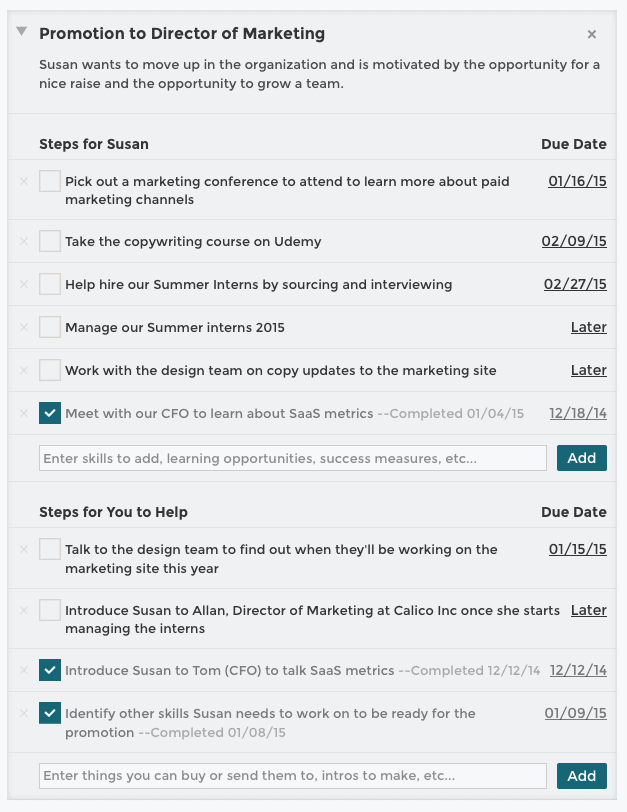Goals: How managers can help their teams reach their goals
“Before you are a leader, success is all about growing yourself. When you become a leader, success is all about growing others.” – Jack Welch, former CEO of General Electric 1981-2001.
One of the most motivating and transformational conversations a manager can have with a team member is about that person’s goals. Not company KPIs, not the next core project and their responsibilities, their goals.
When you tap into someone’s core drive and interests, you unleash their greatest motivations on the job. They’ll even do much of the work on their own time.
According to a study done in 2012, “75% of employees say that they’re willing to use their own time to further their careers and take on additional learning that would benefit them at work.” [Source: pg. 44 The Alliance]
Regardless of age, people have goals that if you tap into, they will be more motivated for all their work and will improve your relationship with you as their manager.
But how do you do that?
I’ve interviewed over 200 managers as I’ve started Lighthouse and had countless informal conversations with others and an all too common theme has been an aversion to discussions about their team’s goals out of a fear of not knowing how to have them. Let’s end that excuse today.

How to Talk About Personal Goals with Your Team
The first step in helping people achieve their goals is to understand what their goals are. For many, they’ve never been asked this question so they may not have a great answer ready. They may also be afraid to share their goals if it doesn’t align perfectly with their current job with you.
To help get a good, honest conversation going, try these tactics:
- Invest in getting to know them more: If you have more rapport with your people by knowing who they are, what their passions are outside of work, and what drives them, they’ll be more likely to open up.
- Tell them their career success matters to you: If you really want them to have happy, fulfilling careers, you need to embrace that they won’t work for you forever. Your reward for this is that they’ll work harder and love working for you while they do. Let them know you have that belief.
- Share your goals first: If you trust them by sharing your goals, they are more likely to share their goals. This is an example of the reciprocity principle.
If someone still isn’t ready to talk about their goals, don’t force it. Help those on your team ready to discuss it and revisit this discussion from time to time.

Ask good questions to spark the conversation:
Now that you’ve built some trust, you need to start asking about their goals. Depending on the culture of your company and how formal your relationship with your team is, different questions may work best. Here’s a few ideas to choose from what works best for you.
From our post on 101 Questions to Ask in one on ones:
There’s a variety of things you can talk about in one on ones. Here’s a selection of some of the ones we collected for talking about long term goals:
- “What are your long term goals? Have you thought about them?”
- “Do you feel like you’re making progress on your big goals here? Why or why not?”
- “Do you feel we’re helping you advance your career at a pace you would like?”
- “What are your super powers? What powers would you like to develop?”
- “What are your big dreams in life? Are you making progress on them?”
- “Could you see yourself making progress on more of your goals here? What would need to change?”
- “What work are you doing here that you feel is most in line with your long term goals?”
- “If you had millions of dollars, what would you do every day?”
- “As a kid, what did you want to be when you grew up?”
From The Alliance by Linkedin cofounder Reid Hoffman, with Ben Casnocha, & Chris Yeh:
The Alliance is all about the new way to manage teams recognizing the current state of the world, where companies are more prone to layoffs and people change jobs frequently. Their focus is on setting up Tours of Duty to create defined jobs aligned with people’s interests and goals, so they have some great questions to spark that conversation:
- “What do you want to be doing in five years?” and work backwards to what needs to be the path starting today.
- “Who do you look at and say, ‘I want to be him/her someday?” and work back on how to get into the kinds of roles they’ve had.
- “What job do you envision having after you leave [this company]?”, which admits the truth that no one works at a company for life anymore, and opens the door to opportunities in other roles in your company they may not know about.
From the team at Next Big Sound:
In a coffee meeting with CEO David Hoffman, I learned they had a simple line of questions that was more fun, and less corporate-y that they used to uncover goals:
- “Imagine it’s 10 years from now and there’s a party celebrating you and your accomplishments . . . Who is there? What music is playing? And what is the accomplishment everyone is there to celebrate?”
- From there, they work backwards to what a 5 year, 3 year, and finally 1 year goal would be to get you closer to that. They then focus on helping you with the 1 year goal.

Don’t just talk. Make progress on their goals.
Talking about their goals is great, but if all you’re doing is talking, it won’t have the lasting, motivating impact on your team.
Too often, I’ve heard from managers and employees alike that goals is often a check box on an annual review that gets filled out and then never discussed until the next review. Not surprisingly, the second time this question is asked in a review, the goal is not exactly something they’re excited to discuss.
Often, this story plays out that the employee gives up on the company helping them reach their goals and eventually leaves to go somewhere else that provides the opportunities that align with their goals and growth.
Instead, you should take advantage of the Progress Principle:
“Of all the things that can boost emotions, motivation, and perceptions during a workday, the single most important is making progress in meaningful work.”
Make progress with small wins.
It’s easy to get intimidated when a goal is large and feels distant. The best way to overcome this is to break the goal into small steps you can both do to help.
So what are some ways to break things down into small steps? Discuss together:
- “What skills do you need to add to be ready for that role? How can you build those skills incrementally?”
- Example: A marketing manager wants to become a director of marketing. They should learn about the company’s revenue metrics so they understand the business drivers better.
- “What project(s) should you be included in?”
- Example: A support team member wants to get into marketing. They could start by contributing to the company blog or help with a new e-book.
- “How could you get more experience in that area?”
- Example: An engineer wants to start giving tech talks at conferences. They could start by giving a talk at lunch to part of the team and then present at a local tech meetup.
- “What do you need to learn more about?”
- Example: A designer is interested in learning more about product management. Buy them a good book, send them some great blog posts, or send them to a conference to learn more.
- “Who would be a good mentor or person to meet to talk about this goal?”
- Example: A product manager wants to learn how to code. Connect them to one of the friendlier engineers on the team who can help them set up a dev environment.
You can also help them by making sure each step follow the classic SMART model:
- Specific – target a specific area for improvement.
- Measurable – quantify or at least suggest an indicator of progress.
- Assignable – specify who will do it.
- Realistic – state what results can realistically be achieved, given available resources.
- Time-related – specify when the result(s) can be achieved.
Managers should have steps to help their teams, too!
While your team member whose goal it is should be putting in the biggest effort to reach their goal, you can do a lot to help them succeed:
- Serve as a mentor yourself: If you’re experienced in their goal, helping them reach it can strengthen your relationship.
- Introduce them to a mentor: Whether inside or out of the company, if you know an expert who can help, you can help your team member tremendously by connecting them to the right person to help. (My career was transformed by such an introduction).
- Buy them a book, resource, or conference pass: As a manager, you likely have at least a modest budget to invest in your team. The right books are a great, inexpensive way to level up your people.
- Get approval for things they need: Going to bat for a team member to get them needed resources or approval for a project will engender great loyalty and appreciation.
- Get them on future related projects: Maybe you can’t help them right away, but remembering the promise to get them involved in a project months or quarters down the line will be something they won’t soon forget.
Here’s an example of what an in-progress goal might look like:

Reflect on and celebrate progress along the way.
As important as all the ways you can contribute to their goal are, you can also help a ton by holding them accountable. When you help them set a big goal or a new area for growth, it’s easy to get discouraged. Reminding them how far they’ve come and celebrating the small wins along the way can keep them motivated to charge ahead on the goal and keep their morale high. A good manager is a coach.
The best time to check in on progress, as well as have the initial goals discussion, is in their one on ones. Since it’s a consistent, private meeting for both of you, it’s easy to make these part of the topics you rotate through. The best managers I’ve spoken to suggest once a month is a good frequency to check in on their goals.
Do’s an Don’ts for Discussing Personal Goals with Your Team
There’s a few closing tips that can help you make they most of these discussions:
- Don’t force it: They have to want it. If they don’t focus on those that do have goals; you’ll get the return on your investment in them and might just set the example that gets others to open up.
- Do experiment without locking in: If they are unsure, don’t create a huge plan. Just create a few steps that will help them explore to see if it really is something they want.
- Don’t go months without checking in: Losing momentum on a goal and feeling like the company doesn’t care is a huge risk if you don’t check in semi-regularly on the goal and celebrate small wins along the way.
- Do talk about it in every few one on ones: Since one on ones are all about them anyways, this is a perfect time to be sure you have on your calendar to have this discussion.
- Don’t be afraid to let people outgrow their role: Expecting people to do the same thing for years is unrealistic. There’s no point in pretending that you’re giving them a job for life or that they’ll work for you forever.
- Do your best to help them succeed: It’s incredibly rewarding to see people on your team grow and go onto to do new, awesome things. They’ll repay you with hard work while they work for you.
- Don’t set too short a time horizon: Be realistic. These goals are usually around other responsibilities, so plan accordingly and don’t be overly ambitious. Steady progress is the goal.
- Do manage their expectations: Big goals and promotions may take years. If you set the expectation from the start that it’s the case, then they’re more likely to stick with it over the long haul.
- Don’t let your own knowledge or skills limit their growth: Especially if you manage people from other disciplines that you came from (like an engineer managing designers), don’t expect to have all the answers yourself.
- Do enlist the help of others to help them succeed: Finding someone the right mentor, or getting advice from the right person on how to help and empower them can transform the progress people can make on a goal.
—-
 Looking for help staying organized and mapping out the growth plans for everyone on your team? Want to keep them together with your one on one notes?
Looking for help staying organized and mapping out the growth plans for everyone on your team? Want to keep them together with your one on one notes?
Then sign up for a free trial of Lighthouse. Built with best practices and the latest workplace research, it helps you make the most of the time you invest in your people.
